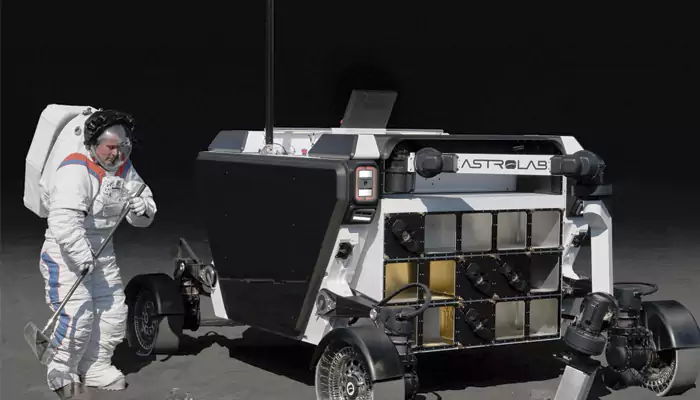Moonwalk 2.0: All You Need to Know about Next-gen 4G-Equipped Spacesuits for Artemis 3 Astronauts
- Soham Halder
- 1 year ago
- 4 minutes read

Welcome to the new era of lunar exploration with cellular network technology.
Artemis 3 was originally planned to be the first manned Moon landing project of this ambitious Artemis program as well as the first crewed spaceflight of the Starship HLS lander. It will be the first American crewed landing on Moon since Apollo 17 in December 1972. However, this upcoming mission will be significant for many reasons. One key aspect is advanced network technology for astronauts. Let's understand about this technology and how it will benefit analyzing real-time data.
State-of-the-art Spacesuits:
The astronauts selected for Artemis 3 will wear specially designed spacesuits with 4G connectivity. It's the same 4G network that people are using currently across the globe.

(Credit - @tobyliiiiiiiiii X handle)
The spacesuit or Axiom Extravehicular Mobility Unit (AxEMU) is equipped with advanced capabilities for lunar exploration. Simply, it is designed for astronauts to access, live and work on lunar surface. Through AxEMU, astronauts will be able to connect to 4G network for broadcasting high-definition (HD) videos.
How this Network Connectivity will be Established?
You might be wondering how this Network will actually function in space. Is it the same like mobile network on the land? Well, the answer is partially yes. Usually, the common mobile networks on the land surface comprises a grid of base stations, which are equipped with a radio array, helping in data transmission. However, this kind of system is impossible to build in space. Thus, the whole base station equipment is compressed into a box, attached with lunar lander.
Nasas Artemis III spacesuit vs Yuri Gagarin’s space suit.(Present Vs Past)
— Black Hole (@konstructivizm) June 26, 2024
“The Artemis III spacesuit prototype, the AxEMU... the final version will likely be all-white when worn by NASA astronauts on the Moon’s surface, Credit: Axiom Space” pic.twitter.com/Nm4KyEOaUV
(Credit - @konstructivizm X handle)
"From a communication perspective, the key components of a smartphone will be integrated with the spacesuit and adapted to the space environment and operational requirements," said Russell Ralston, executive vice president of extravehicular activity at Axiom Space.
Although, the astronauts will not be able to get the benefits of smartphone's touchscreen or interface, but they can directly stream high-definition video or even transmit large volumes of scientific data to the base station. Eventually, those data will be transferred to the Earth for further analysis.
Recently, SpaceX and Axiom Space completed the first integrated test of Artemis III, a first since the Apollo Program.
— Toby Li (@tobyliiiiiiiiii) June 4, 2024
NASA astronauts conducted a pressurized simulation in the HLS Starship airlock mockup while donning the Axiom AxEMU lunar spacesuits ahead of the 2026 mission. pic.twitter.com/8BOhESLBTn
(Credit - @tobyliiiiiiiiii X handle)
More about Operations:
The lunar 4G network is named as Lunar Surface Communications System (LSCS). The whole new technology will be tested for the first time by the end of this year. The test will be conducted through Intuitive Machines' robotic IM-2 mission, after landing near the Moon’s south pole. The base station will be carried by IM-2's lander. The other two payloads named Mobile Autonomous Prospecting Platform (MAPP) rover and the Micro-Nova drone will transport the 4G receivers.
Currently, the astronomers are solely focused on Artemis 3. However, the 4G-equipped spacesuit will be undergoing numerous tests to sustain in harsh environment on the moon for the remainder of 2024 and 2025.
Axiom Space is #BuildingforBeyond by developing @NASA next-generation astronaut spacesuits. The #AxEMU will support the Artemis III lunar mission, as well as future customers on Axiom Station. See the big reveal LIVE Wednesday 9:30 CT https://t.co/8V9NbPrbGB#BuildingHistory pic.twitter.com/OiZiZ2Uk77
— Axiom Space (@Axiom_Space) March 14, 2023
(Credit - @Axiom_Space X handle)
As 4G network revolutionized the connectivity across the globe, the scientists are hopeful for the success of this mission. Even, another ambitious mission, Lunar Terrain Vehicle might also have 4G connectivity.
Over the years, any crewed mission has used ultra-high frequency (UHF) radio for communications. Of course, UHF technology has worked well, but higher bandwidth and speed of 4G connectivity will surely be a gamechanger.












